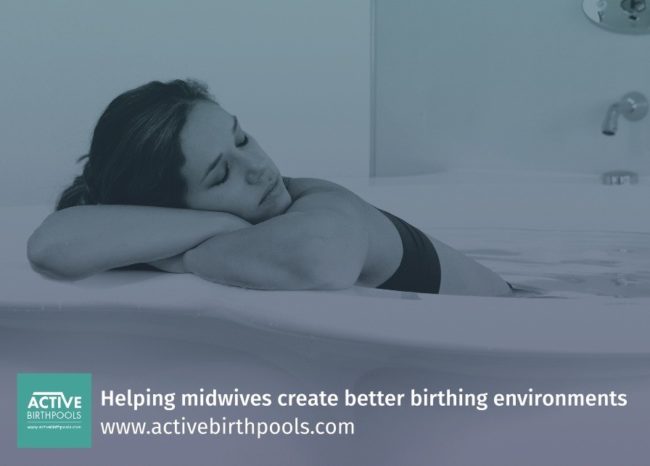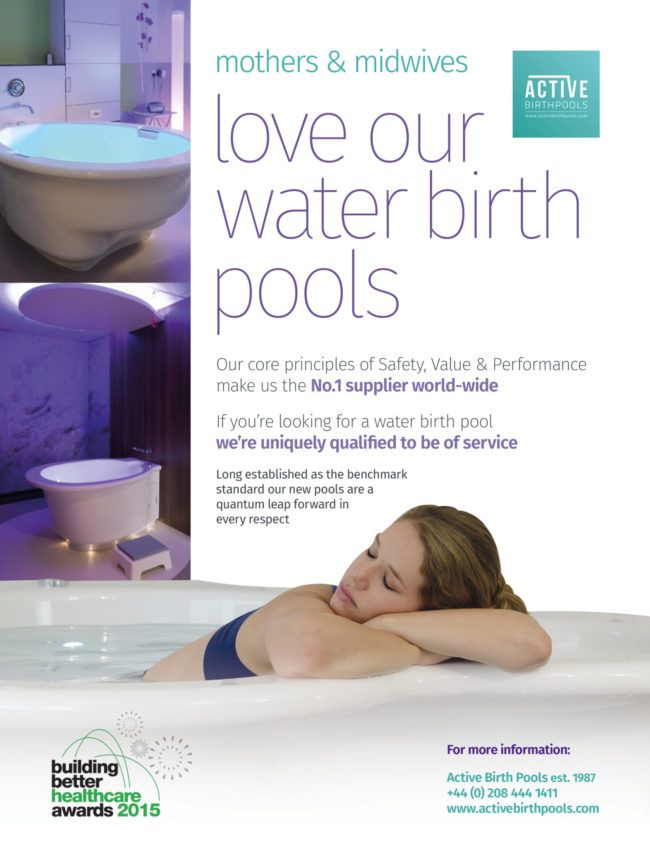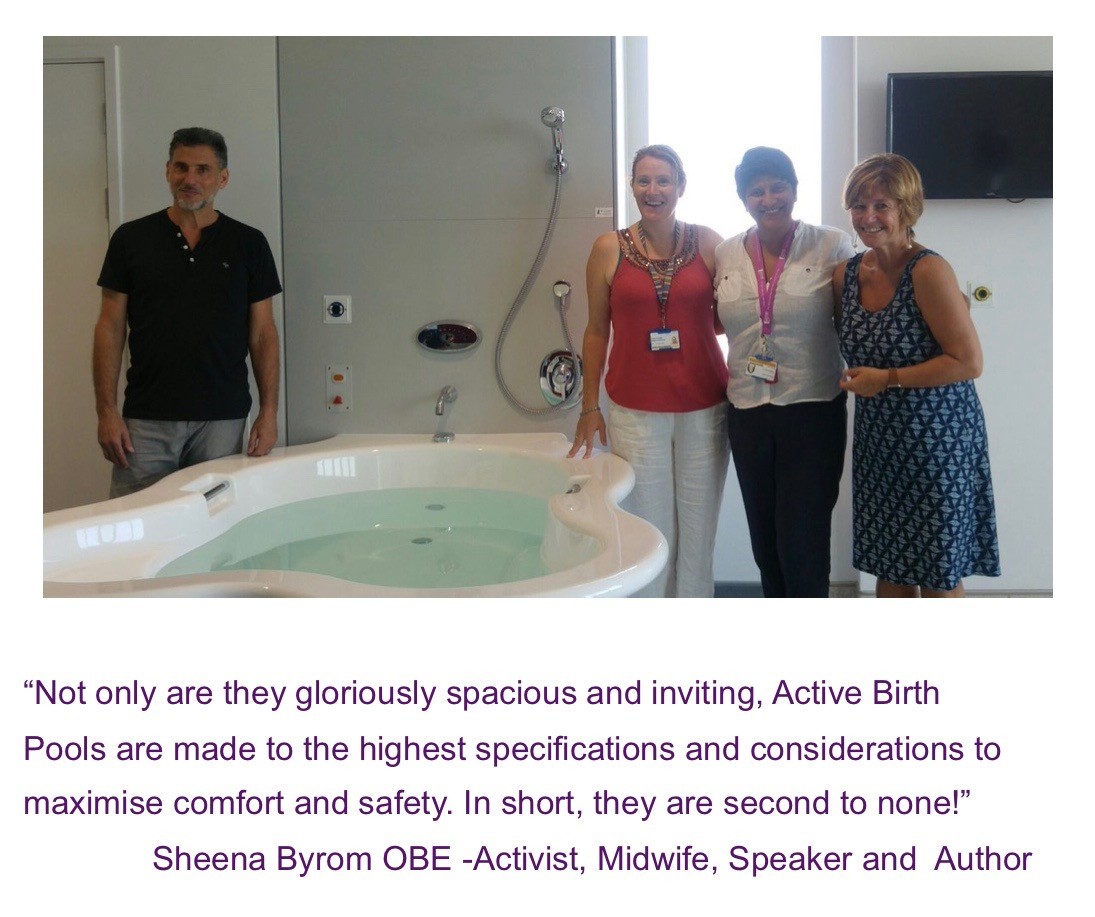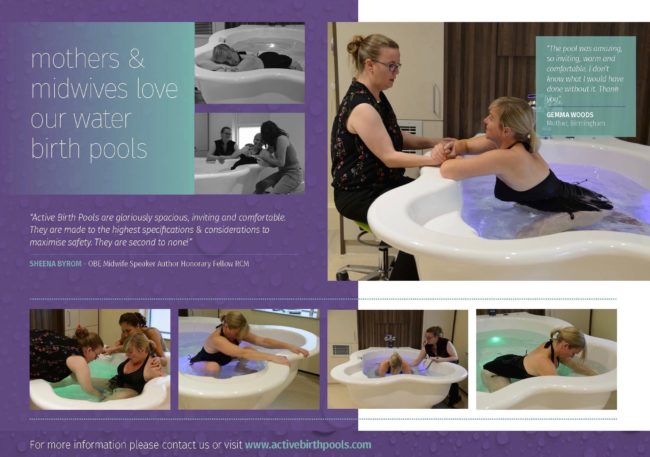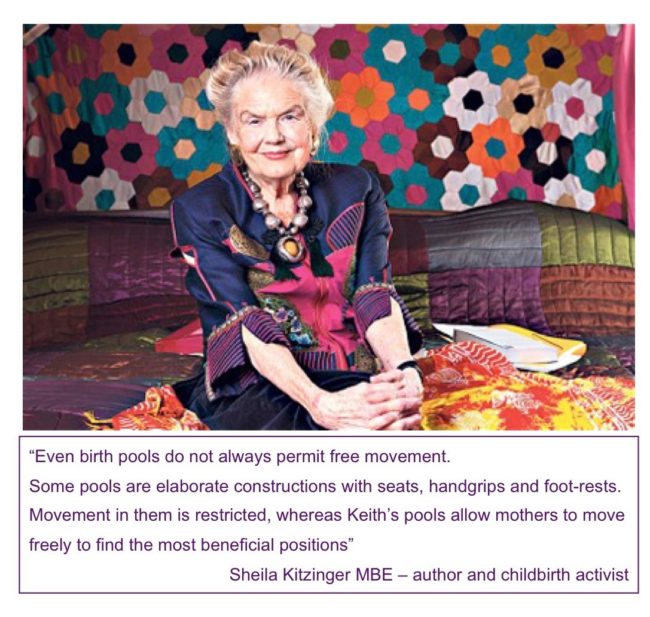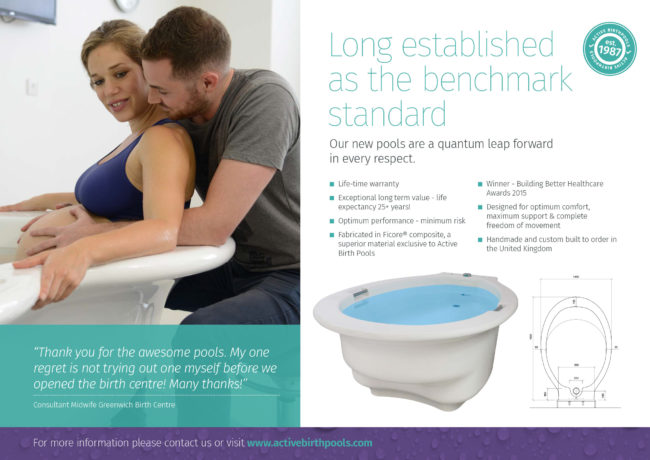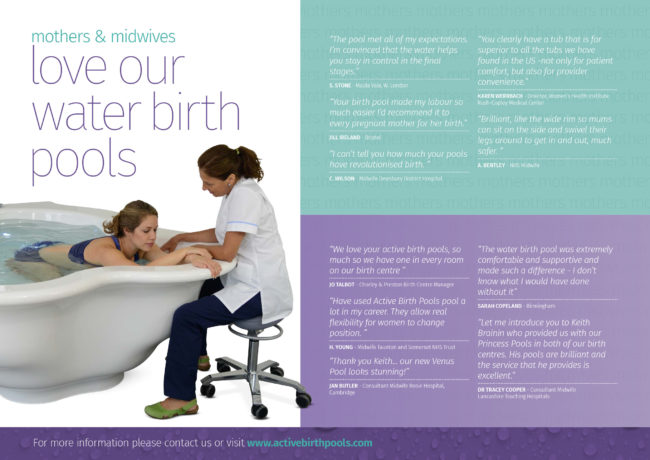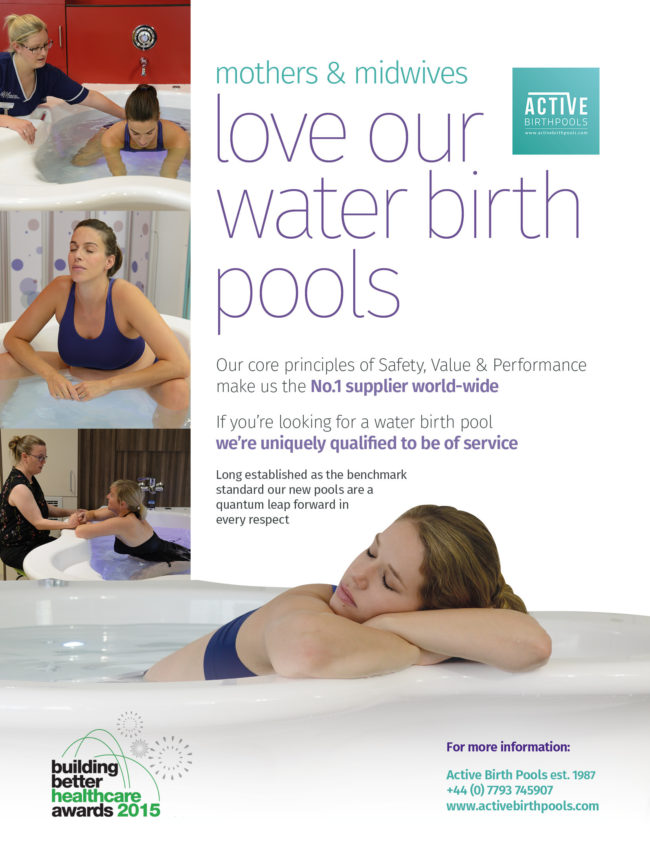Since the early 1980s use of immersion in water during labour and birth has been increasingly promoted to enable women to relax, help them cope with pain, and maximise their feelings of control and satisfaction1-4.
In 1992 the House of Commons Health Committee recommended all hospitals provide the option of a birthing pool where practicable5. Currently few women give birth in water but the option of immersion or showering during the first stage of labour is commonly available.6-8
Although problems have arise which have been attributed to water use, the results of the most formal evaluations have not clearly associated water use with harmful outcomes for mother or baby 3,9-13.
The lack of robust evidence of harm or benefit means that childbearing women and health practitioners alike are subject to conflicting opinion about the usefulness and safest of water, particularly for birth.
However, a recent observational study over a nine year period concluded that ‘waterbirth was associated with low risks where obstetric guidelines were followed’16.
At present in the UK there is no reliable measurement of the rate of birth in water.
A national survey of maternity units in the UK in 2002 found that 63% (216/342) had a birthing pool8; 67% (228/342) reported having at least one midwife trained to provide support for women giving birth in water and 36% (121/342) said that at least half of the midwives working in their unit were trained to support birth in water.
How is water used during labour?
Water use ranges from informal, for example when a woman in early labour decides to get into her bath at home before going to hospital, to formal use in a specially designed birthing pool. Informal use in a domestic bath or shower is often initiated by a woman herself to help her cope at home before her labour is well established.
Formal use implies either that a woman has actively chosen to use water as part of her plan for labour and/or childbirth or that a health professional, usually a midwife, has suggested use during established labour.
Why water use is promoted
Use of immersion in water during childbirth has largely been driven by pregnant and birthing women17 and supported by midwives. During the first stage of labour it is advocated to shorten labour and help a woman relax and cope with contractions, feel more in control, and to reduce intervention by health professionals3,18-21.
During the second stage, proponents use it to allow perineal tissues to stretch spontaneously, birth to occur with minimum intervention, and to provide the baby with a gentler transition into extra-uterine life. Expectant management of the third stage is likely if a woman is in water.
Limitations on water use
Many health professionals consider that water use during the first stage of labour in uncomplicated pregnancy is unlikely to harm the mother or baby22,23, whilst others have concerns about water use at any point in labour14.
Local clinical guidelines may restrict water use to women considered at ‘low’ obstetric risk7, and other aspects of care may be prescribed, for example when and how to monitor the temperature of the water, the degree of cervical dilatation at which to begin its use24, and whether the immersion is considered safe for all stages of labour6,25.
Problems associated with possible risk of infection or cross infection caused by amniotic fluid, blood, and faeces have been described26-28 and some hospitals have restricted use of birthing pools to women who have tested HIV negative during pregnancy29.
However, at a multi-disciplinary consensus meeting held in London in 1996, it was agreed that mandatory HIV testing for prospective users of birthing pools could be an extreme reaction to the perceived risks and that high standards of pool hygiene would be an appropriate way forward30. Local infection control guidelines should cover the use of water pools25,31 and procedures to minimise risk of cross infection13, 32.
It has been suggested that high water temperature can cause serious changes in feto-maternal haemodynamic regulation and fetal thermoregulation33. It has been reported that fetal tachycardia can be reduced by cooling the water34 and most providers and clinical guidelines specify a temperature range within which the water should be maintained during the first and second stage of labour7,35.
The prospect of a woman giving birth in water can cause anxiety about how to deal with unexpected emergencies such as shoulder dystocia, the need to avoid the baby inhaling water, or being unaware that the umbilical cord has been severed11.
Despite the fact that it denies women choice about birth, one response has been to limit water use to first stage only6. Development of agreed clinical protocols to deal with unexpected complications25 and providing training which allows3 staff to achieve relevant competencies is key to enabling real choice for women about use of water.
There are theoretical risks of increased blood loss, retained placenta, or water embolism, and professional advice is often to conduct the third stage out of water25.
Because water adds to the difficulty of estimating blood loss accurately, it has been proposed that blood loss would be more appropriately estimated as being either more or less than 500ml36 and that the overall physical condition of the woman should be used as the most important indicator to assess the impact of any bleeding37.
In summary, although not universally accepted, first stage water use is less controversial than immersion for the second or third stage of labour22,23,38.
The research evidence
The effects of water use during the first stage of labour on maternal and fetal outcomes have been evaluated in several randomised controlled trials4,9,10,12,13,39 with sample sizes ranging from 60 to 123934.
The use of water has been shown to reduce the rate of augmentation40; however, no trial has been large enough to measure the effect of water use on important neonatal outcomes such as perinatal death or other serious neonatal or maternal morbidity.
In addition, there has often been significant cross-over between study groups4,12, reducing the likelihood of identifying clear differences between women allocated to water use and those not.
A systematic review of eight trials41 indicated a statistically significant reduction in the use of pain relief with no such significant difference in the rate of operative deliveries or in neonatal outcomes.
It concluded that while the use of water in the first stage of labour can be of benefit to some women, there is no evidence at present to support or not support a woman’s choice to give birth in water.
Retrospective comparison has been made of women who have used water with those who have not42,43.
However, there are considerable difficulties in interpreting such studies because of the possibility that the results are inherently biased.
In the same way, findings of cohort studies which suggest benefit for water use in terms of pain relief and increased rate of cervical dilatation44-47, or those which indicate differences in rates of maternal and neonatal infection48-50, are also open to criticism.
A recent study16 compared neonatal and maternal morbidity and mortality for spontaneous singleton births that took place in water or on land.
This was an observational study over a nine year period and data were obtained through standardised questionnaires for 9,518 births, of which 3,617 were waterbirths and 5,901 landbirths.
Statistically significant differences were identified between the two groups; women who gave birth using water were less likely to suffer serious perineal trauma, use no analgesia and have a lower blood loss than women in the landbirth group.
Maternal and neonatal infection rates were the same for both groups, but more landbirth babies had neonatal complications requiring transfer to an external NICU.
During the study, there were neither maternal nor neonatal deaths related to spontaneous labor.
The authors acknowledge the potential bias that could arise from the self-selection issue but argue that this is well accounted for in the analysis.They conclude that waterbirths are associated with low risks for both mother and child when obstetrical guidelines are followed.
Another study51 based in a centre for low risk women was a retrospective case review over a five year period of 1355 births in water.
When compared with land births over a corresponding period, women who gave birth in water had significantly fewer episiotomies with no evidence of a corresponding rise in lacerations, a reduction in the length of the first stage of labour, no increase in the risk of acquired infection or aspiration pneumonia and considerably lower levels of analgesia use.
Neonatal condition assessed by arterial cord blood pH, base excess and birth weight showed no differences.The authors conclude that this represents a realistic option for women at low risk of complications.
Many reports about water use are case series1,20,52-62 and focus on perceived benefits of water use for the mother, her baby and birth attendant.
These include shorter labour52, less use of pharmacological analgesics46,53, less intervention by care givers19, lower rate of perineal trauma60-62, and increased satisfaction with the experience of labour and birth54.
By contrast, some case reports have highlighted serious problems such as fetal overheating33,34, neonatal sepsis28, near drowning63 or death64.
Overall, reviews of the evidence21,23,65,66 conclude that appropriately large-scale research is still required to evaluate rigorously the physiological effects13, clinical outcomes, and economic impact of water use.
What we don’t know
The current evidence about water use remains quite heavily dependent on case series and comparison studies that include varying sized samples.
Therefore, reliable evidence about efficacy and effectiveness is still equivocal67.
- Outstanding issues which require evaluation include:
- is water use causally associated with an increase in perinatal mortality or serious perinatal morbidity?
- at what dilatation should a woman be advised to begin water use?
- does the size or shape of the water container affect outcomes?
- if water has an effect on important physical/psychological outcomes for mothers or babies, are there particular women who should avoid using water during labour?
- to what extent immersion in water affects the length of labour?
Implications for maternity
Water use during the first stage of labour is offered by the majority of maternity care provider units in the UK and most offer support for water birth8.
Introduction of, and sustained suppor t for, water use may have considerable implications for service governance68.
However, not all costs fall to providers of care; a substantial cost burden is likely to be borne by labouring women themselves during informal use in domestic baths and showers or by hiring specially designed pools for use in their home or in a maternity unit.
Most maternity units have installed a water pool for use in labour8 and although installation and maintenance of a specially designed pool in a maternity unit involves obvious financial cost, this may be offset if there is a reduction in analgesia and anaesthetic use44.
There is evidence that formal water use means that at least one midwife will be in constant attendance during the first stage of labour and that at least two will be in attendance for birth7.
This level of staffing may be difficult to sustain and may have implications for equity of care for women who do not use water22.
Clear strategies for the training, preparation and support of staff who offer use of water during labour are recognised as essential7,25,31,37,44.
Key components of these include clarification of the roles of different maternity health professionals, multi-disciplinary development of local protocols, development of guidelines for clinical practice, and short-term secondment of midwives to learn alongside practitioners skilled and experienced in water use.
Implications for practice
Women may choose to use immersion in water during labour and/or birth. Midwives and other maternity care workers should therefore be knowledgeable about the evidence in terms of potential advantages and disadvantages.
Given the current quality of reliable evidence, effective practice is likely to be informed and influenced substantially by shared experience and personal observation.
Disproportionate weight may therefore be placed on perceived disadvantages or advantages and credibility given to outcomes which may not be associated causally with water use.
Practitioners should be alert to the evolving evidence base which underpins the use of water.
- Immersion in water during childbirth is a care option women may wish to choose and which health professionals have a responsibility to discuss and support using clear and balanced information.
- As with any labour or birth, it is essential to maintain systematic, contemporaneous records and to monitor and record routine observations about the well-being of the mother and the fetus. These data should be used to audit care and gather information about outcomes.
- Water temperature should be measured regularly using a thermometer and recorded.The water temperature should be comfortable for the woman and should be not more than 37°C during the first stage of labour and between 36-37°C in the second stage.
- Maternal faeces, meconium and blood clots should be removed from the water using a sieve, and effective cleaning of pools before/after use should be carried out to minimise risk of infection or cross-infection.
- Birth in water: the baby should be born fully submerged and be brought gently and without delay to the surface so that he/she can make their first respiratory efforts in air.
- Comprehensive, large scale research is required to address questions about the safety and effectiveness of using water during labour and/or birth.
Reproduced from Midirs 2005, last revised Jan 2005, review date Jan 2007. Informed Choice is supported by the Royal College of Midwives and the National Childbirth Trust.
References
- Odent M. Bir th under water. Lancet 1983;2:1476-7.
- Rosenthal MJ.Warm-water immersion in labor and birth. Female Patient 1991;16:35-47.
- Balaskas J, Gordon Y. Water birth. London:Thorsons, 1992.
- Rush J, Burlock S, Lambert K et al.The effects of whirlpool baths in labor: a randomized, controlled trial. Birth 1996;23:136-43.
- House of Commons (1991-92). Health Committee. Second report. Maternity services. HC 29-I. London, HMSO, 1992.
- Alderdice F, Renfrew M, Marchant S et al. Labour and bir th in water in England and Wales, BMJ 1995;310:837.
- Marchant S,Alderdice F,Ashurst H et al.Labour and birth in water:national variations in practice.Br J Midwifery 1996;4:408-12,429-30.
- Gold L. Good Birth Guide. London:Vermillion, 2002.
- Schorn MN, McAllister JL, Blanco JD.Water immersion and the effect on labor. J Nurse Midwifery
1993;38:336-42.
- Cammu H, Clasen K,Van Wettere L et al.‘To bathe or not to bathe’ during the first stage of labor.
Acta Obstet Gynecol Scand 1994;73:468-72.
- Gilbert RE,Tookey PA. Perinatal mortality and morbidity among babies delivered in water:
surveillance study and postal survey. BMJ 1999;319:483-7.
- EckertK,TurnbullD,MacLennanA.Immersioninwaterinthefirststageoflabor:arandomized
controlled trial. Birth 2001;28:84-93.
- Woodward J,Kelly SM.A pilot study for a randomised controlled trial of waterbirth versus land birth.
BJOG 2004;111:537-45.
- Chamberlain G. Statement on birth underwater. London: Royal College of Obstetricians and Gynaecologists, 1993.
- FlintC.Waterbirthandtheroleofthemidwife.In:BeechBALed.Waterbirthunplugged.Hale:Books for Midwives Press, 1996:60-2.
- GeissbuehlerV, Stein S, Eberhard J.Waterbirths compared with landbirths: an observational study of nine years. J Perinat Med 2004;32(4):308-14.
- Richmond H.Women’s experience of waterbirth. Practising Midwife 2003;6:26-31
- Labourandbirthinwater.London:NCT,2002.
- Birthwithoutviolence.Reved.London:Mandarin,1991.
- Church LK.Water birth: one birthing center’s observations. J Nurse Midwifery 1989;34:165-70.
- McCandlishR,RenfrewM.Immersioninwaterduringlaborandbirth:theneedforevaluation.Birth 1993;20:79-85.
- Mills MS, Stirrat GM.Water immersion and water birth. Curr Obstet Gynaecol 1996;6:35-39.
- Johnson P. Birth under water – to breathe or not to breathe. Br J Obstet Gynaecol 1996;103:202-8.
- ErikssonM,MattssonLA,LadforsL.Earlyorlatebathduringthefirststageoflabour:arandomised study of 200 women. Midwifery 1997;13:146-8.
- Birthinwater.London:RCOG,2001. http://www.rcog.org.uk [accessed June 2003]
- ParkerPC,BolesRG.Pseudomonasotitismediaandbacteremiafollowingawaterbirth.Pediatrics 1997;99:653.
- RidgwayGL,TedderRS.Birthingpoolsandinfectioncontrol.Lancet1996;347:1051-2.
- Hawkins S.Water vs conventional births:infection rates compared.NursTimes 1995;91(11):38-40.
- TrustdemandsHIVtestforpoolbirths.NursTimes1996;92(2):9.
- HIVtransmissioninbirthingpools.London:TerrenceHigginsTrust,1996.
- Royal College of Midwives. The use of water in labour and birth. London: Royal College of Midwives, 2000.
- Schulster L, Chinn RYW. Guidelines for environmental infection control in health care facilities. Morbidity and Mortality Weekly Report 2003;52/RR-10:20-1.
- RosevearSK,FoxR,MarlowNetal.Birthingpoolsandthefetus.Lancet1993;342:1048-9.
- DeansAC,SteerPJ.Temperatureofpoolisimportant.BMJ1995;311:390-1.
- Waterbirth:anattitudetocare.Hale:BooksforMidwivesPress,1995:66.
- Theuseofwaterduringbirth.London:RCM,1994.
- Beech BAL.Water birth – a passing fad? Mod Midwife 1997;7(5):11-4.
- RosserJ.Iswaterbirthsafe?Thefactsbehindthecontroversy.MIDIRSMidwiferyDig1994;4:4-6.
39.
- Ohlsson G, Buchhave P, Leandersson U et al.Warm tub bathing during labor: maternal and neonatal effects. Acta Obstet Gynecol Scand 2001;80:311-4.
- Cluett ER, Pickering RM, Getliffe K et al. Randomised controlled trial of labouring in water compared with standard of augmentation for management of dystocia in first stage of labour. BMJ 2004;328:314-318.
- CluettER,NikodemVC,McCandlishREetal.Immersioninwaterinpregnancy,labourandbirth. The Cochrane database of Systematic Reviews 2004, issue 1.
- Burke E,KilfoyleA.A comparative study:waterbirth and bedbirth.Midwives 1995;108:3-7.
43.
- Otigbah CM,Dhanjal MK,Harmsworth G et al.A retrospective comparison of water births and conventional vaginal deliveries. Eur J Obstet Gynecol Reprod Biol 2000;91:15-20.
44.
- LenstrupC,SchantzA,BergetAetal.Warmtubbathduringdelivery.ActaObstetGynecolScand 1987;66:709-12.
- Waldenstrom U, Nilsson CA.Warm tub bath after spontaneous rupture of the membranes. Birth 1992;19:57-63.
- GeissbuhlerV,Eberhard J.Waterbirths:a comparative study.Fetal DiagnTher 2000;15:291-300. 47.
- AirdIA,LuckasMJM,BuckettWMetal.Effectsofintrapartumhydrotherapyonlabourrelated parameters. Aust NZ J Obstet Gynaecol 1997;37:137-42.
48.
- AndersenB,GyhagenM,NielsenTF.Warmbathduringlabour.Effectsonlabourdurationand maternal and fetal infectious morbidity. J Obstet Gynaecol 1996;16:326-30.
- Eriksson M, Ladfors L, Mattsson LA et al.Warm tub bath during labor.A study of 1385 women with prelabor rupture of the membranes after 34 weeks of gestation. Acta Obstet Gynecol Scand 1996;75:642-4.
- FordeC,CreightonS,BattyAetal.Labouranddeliveryinthebirthingpool.BrJMidwifery 1999;7:165-71.
- Thoni A, Moroder L.Waterbirth: a safe and natural delivery method: experience after 1355 waterbirths in Italy.MidwiferyToday 2004;70:44-8.
- Garland D, Jones K.Waterbirth,‘first stage’ immersion or non-immersion? Br J Midwifery 6 1994;2:113-20.
- Rosenthal M.The use of warm immersion in labour at the Family Birthing Centre of Upland (California). In: Beech BAL ed. Water birth unplugged. Hale: Books for Midwives Press, 1996:92-5.
- HaddadF.Labourandbirthinwater:anobstetrician’sobservationsoveradecade.In:BeechBALed. Water birth unplugged. Hale: Books for Midwives Press, 1996:96-108.
- BurnsE,GreenishK.Poolinginformation.NursTimes1993;89(8):47-9.
56.
- Nightingale C.Water and pain relief – observations of over 570 births at Hillingdon. In: Beech BAL ed.Water birth unplugged. Hale: Books for Midwives Press, 1996:63-9.
57.
- Muscat J.A thousand water births:selection criteria and outcome.In:Beech BAL ed.Water birth unplugged. Hale: Books for Midwives Press, 1996:77-81.
58.
- AdamM.WaterbirthinVienna:facts,thoughtsandphilosophyoftheGeburtshausNussdorf.In: Beech BAL ed.Water birth unplugged. Hale: Books for Midwives Press, 1996:82-7.
59.
- UllerA.WaterbirthinDenmark.In:BeechBALed.Waterbirthunplugged.Hale:BooksforMidwives Press, 1996:119-29.
- Brown L.The tide has turned: audit of water birth. Br J Midwifery 1998;6:236-43.
- GarlandD,JonesK.Waterbirth:supportingpracticewithclinicalaudit.MIDIRSMidwiferyDig 2000;10:333-6.
- Burns E.Waterbirth. MIDIRS Midwifery Dig 2001;11(suppl 2):S10-3.
63.
- Nguyen S, Kuschel C,Teele R et al.Water birth – a near-drowning experience. Pediatrics 2002;110:411-3.
- RobinsonJ.AwaterbirthdeathinSweden.AIMSJ1993;5:7-8.
- GarlandD,JonesK.Waterbirth:updatingtheevidence.BrJMidwifery1997;5:368-73.
- BeakeS.Waterbirth:aliteraturereview.MIDIRSMidwiferyDig1999;9:473-7.
- Grunebaum A, Chervenak F.The baby or the bathwater: which should be discarded? Perinat Med 2004;32(4):306-7.
- JenkinsR.Assessingtheeffectofanewhealthtechnology.In:BeechBALed.Waterbirthunplugged. Hale: Books for Midwives Press, 1996:53-8.
